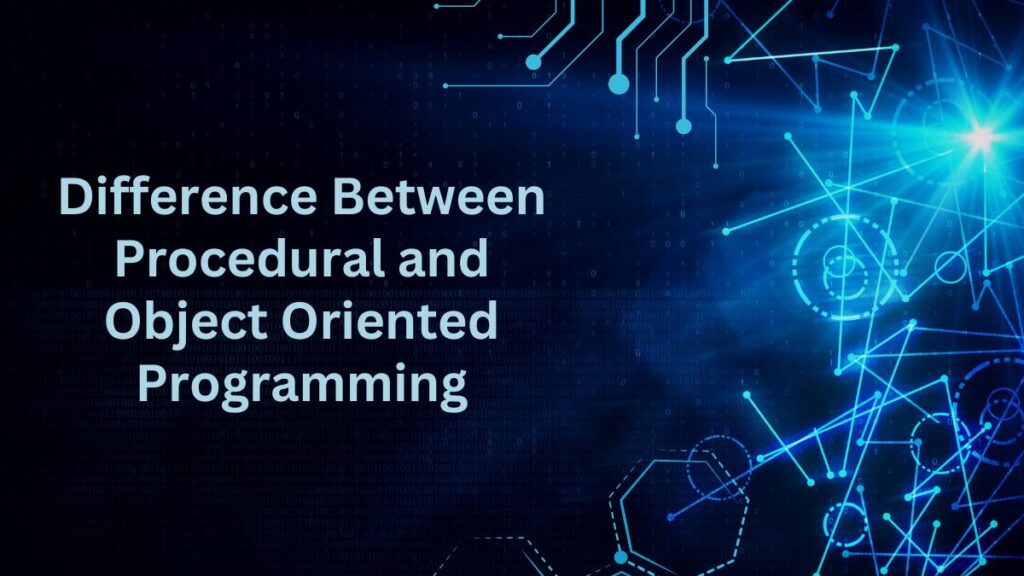Imagine programming languages as tools in a developer’s toolbox, like different utensils in a kitchen. Each tool has a specific job and a unique way of doing things. In this blog, we’ll talk about the difference between procedural and object oriented programming.
Procedural programming is like following a recipe when you cook. You have a set of instructions that you follow one after the other to make a dish. In the programming world, this means organizing your code into step-by-step functions.
On the other hand, object-oriented programming (OOP) is more like playing with building blocks. You have different types of blocks, each with its special abilities and purposes. In programming, this means creating objects with their own unique features and actions.
We’re here to simplify these concepts and explain the differences between them, so you can choose the right method for your programming needs.
Let’s dive in!
| When it comes to tackling challenging programming assignments, whether you’re following the procedural path or diving into the world of object-oriented programming, remember that there’s always a helping hand available. If you ever find yourself needing expert assistance or guidance, consider checking out ‘programming assignment help‘ to make your coding journey smoother. You can access this valuable resource to get the support you need for your programming tasks. |
Procedural Programming
Table of Contents
Procedural programming is like following a recipe in the kitchen. You have a set of instructions, and you follow them step by step to achieve your goal. In procedural programming:
- Focus on Procedures: Code is organized into functions or procedures. Each function performs a specific task, and these functions are called one after another to accomplish a task.
- Global Data: Data is often stored in global variables, accessible to all functions in the program. This can sometimes lead to unintended consequences if data is modified unexpectedly.
- Limited Reusability: Functions can be reused, but they are not bundled with data. You need to pass data explicitly to functions, which can become cumbersome as the program grows.
- Example: Think of procedural programming as making a sandwich. You have separate steps like cutting the bread, spreading butter, adding cheese, and so on, each represented by a separate function.
Object-Oriented Programming (OOP)
Object-oriented programming is like building with LEGO bricks. You have different pieces (objects), each with its own unique properties and functions. In OOP:
- Focus on Objects: Code is organized around objects, which are instances of classes. Each object has both data (attributes) and methods (functions) that operate on that data.
- Encapsulation: Objects encapsulate their data, meaning they control access to it. You can’t directly access or modify an object’s data from outside, promoting data integrity.
- Reusability: OOP promotes reusability through inheritance and polymorphism. You can create new classes based on existing ones, inheriting their attributes and behaviors.
- Example: Imagine you’re building a car. In OOP, you’d have a “Car” class with attributes like color, speed, and methods like “accelerate” and “brake.” You can create multiple car objects from this class, each with its unique data.
Key Difference Between Procedural and Object Oriented Programming
Now that we’ve introduced both paradigms, let’s compare them more directly:
- Organization: Procedural programming uses functions to organize code, while OOP uses objects and classes.
- Data Handling: Procedural programming often relies on global data, whereas OOP encapsulates data within objects.
- Reusability: OOP encourages reusability through inheritance and polymorphism, making it easier to extend and maintain code.
- Complexity: OOP tends to be more suitable for complex systems where data and behavior need to be tightly connected.
- Real-World Analogy: Procedural programming is like following a recipe, while OOP is like building with LEGO bricks.
When to Choose Procedural Programming:
Imagine you have a small task, like making a simple drawing or calculating some basic math. In this case, procedural programming is like using a quick and straightforward recipe. It’s great for small projects where you don’t need to handle lots of different things at once. You can write a series of steps (functions) to get the job done step by step.
For example, if you need to add up numbers or display a simple message, procedural programming is like following a basic set of instructions, just like making a simple sandwich. It’s quick and easy.
When to Choose Object-Oriented Programming (OOP):
Now, think about a big project, like building a whole city with roads, buildings, and people. This is where OOP shines. When your project becomes larger and more complex, with lots of different things interacting with each other, OOP is like having a blueprint for each part of the city.
With OOP, you can create well-organized objects (blueprints) for each part of your project, and these objects can work together smoothly. This makes it easier to manage big projects, keep your code organized, and even use parts of your project in other projects (just like using the same type of building blocks in different cities).
So, in a nutshell, use procedural programming for small, simple tasks, and use OOP when your project gets big and complex, and you want to keep things tidy and reusable.
Conclusion
In the world of programming, procedural and object-oriented paradigms are two essential approaches, each with its strengths and use cases. Remember that it’s not about one being better than the other; it’s about choosing the right tool for the job. As you gain experience, you’ll find that you can even combine these paradigms to create efficient and flexible solutions to a wide range of programming challenges.
